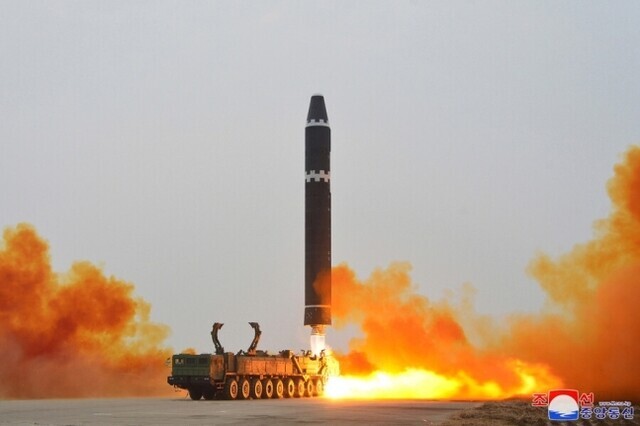hankyoreh
Links to other country sites 다른 나라 사이트 링크
[Editorial] Korean Peninsula must choose diplomacy over brinkmanship

North Korea’s test launch of an intercontinental ballistic missile (ICBM) on Saturday sent a signal that it plans to continue its intensive shows of force in 2023.
The situation is part of escalating confrontations between South Korea, the US, and Japan on one side and North Korea, China, and Russia on the other. This sort of dangerous brinkmanship is deeply worrying.
North Korea announced that the launch was part of surprise launch exercises with the Hwasong-15 ICBM under the direction of the Missile General Bureau, based on orders issued by leader Kim Jong-un. The missile in question is believed to have a range of around 15,000 kilometers (9,320 miles), which would pose a threat to the US’ entire territory.
In a statement on Sunday, Kim Yo-jong, a vice department director for the Workers’ Party of Korea and the sister of Kim Jong-un, warned that the North would “watch every movement of the enemy and take corresponding and very powerful and overwhelming counteraction against its every move hostile to us.”
The North’s decision to test-launch an ICBM just 48 days after its launch of a medium-range ballistic missile on the first day of 2023 appeared first and foremost intended as a protest against joint South Korea-US military exercises.
The US Defense Department plans to hold extended deterrence operation exercises on Wednesday, while the large-scale Freedom Shield exercises with South Korea are scheduled to take place in mid-March.
In a recent statement credited to a spokesperson from its Foreign Ministry, North Korea warned, “In case the U.S. and south Korea carry into practice their already-announced plan for military drills [. . .] they will face unprecedentedly persistent and strong counteractions.”
In the broader scheme of things, the launch is being read as part of an effort to reinforce ties with China and Russia in the face of stronger cooperation among South Korea, the US, and Japan.
In her statement, Kim Yo-jong denounced the UN Security Council as a “tool for [the US’] heinous hostile policy toward the DPRK” and stressed that China and Russia “should never tolerate the high-handed and arbitrary practices of the US.”
The message was a call for Beijing and Moscow to oppose Washington’s efforts in the UNSC to pursue additional resolutions sanctioning the North.
South Korea has shown a hard-line stance both on its own and in conjunction with the US and Japan. In its defense white paper this year, the Ministry of National Defense defined North Korea as an “enemy.”
The South Korean, US, and Japanese foreign ministers held an emergency press conference in Munich on Saturday to denounce North Korea’s ICBM launch. On Sunday, South Korea and the US held aerial drills over the Korean Peninsula, which included the US’ B-1B strategic bomber.
There has been a conspicuous absence of mediators and buffer zones as the political situation on the Korean Peninsula races toward a cliff. If things continue at the current rate, there is a very real danger that some unintended clash could ignite into flames that engulf the peninsula and East Asia as a whole.
Even as we beef up our security posture, we also need concurrent, cautious diplomatic efforts and management of the situation to prevent a collision.
Please direct questions or comments to [english@hani.co.kr]

Editorial・opinion
![[Editorial] Penalties for airing allegations against Korea’s first lady endanger free press [Editorial] Penalties for airing allegations against Korea’s first lady endanger free press](https://flexible.img.hani.co.kr/flexible/normal/500/300/imgdb/original/2024/0502/1817146398095106.jpg) [Editorial] Penalties for airing allegations against Korea’s first lady endanger free press
[Editorial] Penalties for airing allegations against Korea’s first lady endanger free press![[Editorial] Yoon must halt procurement of SM-3 interceptor missiles [Editorial] Yoon must halt procurement of SM-3 interceptor missiles](https://flexible.img.hani.co.kr/flexible/normal/500/300/imgdb/child/2024/0501/17145495551605_1717145495195344.jpg) [Editorial] Yoon must halt procurement of SM-3 interceptor missiles
[Editorial] Yoon must halt procurement of SM-3 interceptor missiles- [Guest essay] Maybe Korea’s rapid population decline is an opportunity, not a crisis
- [Column] Can Yoon steer diplomacy with Russia, China back on track?
- [Column] Season 2 of special prosecutor probe may be coming to Korea soon
- [Column] Park Geun-hye déjà vu in Yoon Suk-yeol
- [Editorial] New weight of N. Korea’s nuclear threats makes dialogue all the more urgent
- [Guest essay] The real reason Korea’s new right wants to dub Rhee a founding father
- [Column] ‘Choson’: Is it time we start referring to N. Korea in its own terms?
- [Editorial] Japan’s rewriting of history with Korea has gone too far
Most viewed articles
- 160% of young Koreans see no need to have kids after marriage
- 2Presidential office warns of veto in response to opposition passing special counsel probe act
- 3Hybe-Ador dispute shines light on pervasive issues behind K-pop’s tidy facade
- 4Months and months of overdue wages are pushing migrant workers in Korea into debt
- 5[Editorial] Penalties for airing allegations against Korea’s first lady endanger free press
- 6Japan says it’s not pressuring Naver to sell Line, but Korean insiders say otherwise
- 7OECD upgrades Korea’s growth forecast from 2.2% to 2.6%
- 8Bills for Itaewon crush inquiry, special counsel probe into Marine’s death pass National Assembly
- 9[Guest essay] Maybe Korea’s rapid population decline is an opportunity, not a crisis
- 10[Reporter’s notebook] In Min’s world, she’s the artist — and NewJeans is her art